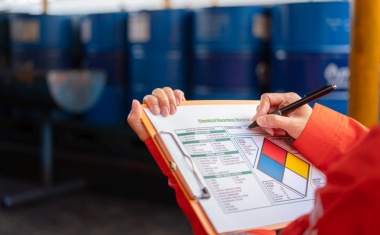Surfactants in a Globalizing World


The 10th CESIO World Surfactant Congress and Business Convention in Istanbul, Turkey, 1-3 June, 2015 organized on behalf of the European Committee of Organic Surfactants and their Intermediates (CESIO) will showcase an extensive scientific program on the main theme "Surfactants in a Globalizing World - Creating new Possibilities". Sessions, posters and exhibition will cover the scientific, economic, technical, as well as safety and regulatory aspects of surfactants and surfactant applications in the industry and consumer products. In the run-up to the event, Michael Reubold asked John Hibbs, President Elect of CESIO, to provide a status report on the industry and a sneak preview on what will be discussed in Istanbul.
CHEManager International: Mr Hibbs, this year's congress theme is "Surfactants in a Globalizing World - Creating New Possibilities". Which new possibilities can you imagine and what will it need to take advantage of them?
J. Hibbs: Surfactants have and have always had a very large range of applications, because of their versatility. Industry has, and continues to be able to innovate to meet the requirements of growing demands, and increasing constraints, in terms of regulatory and user requirements. We see surfactants being used to replace traditional solvents, giving lower risk and reduced environmental impacts. Surfactants can play a key role in the development of technologies such as nanomaterials, and the use of surfactants and soluble polymers is a major enabler in the efficient extraction of our oil resources.
How have the global and the European market for surfactants as a whole developed in recent years and what are your growth expectations for the years to come?
J. Hibbs: It is widely believed that the demand for surfactants grows in line with GDP, and this is generally what we see. In developing regions we also see a link to population growth. In the future, we expect this trend to continue, since surfactants are an important contributor to the quality of life. The European demand for surfactants is fairly static in terms of volume (in line with the region's economic trends) however there is a requirement for more sustainable and effective materials, ensuring a demand for innovation and technological development.
What are the main growth drivers in terms of geographies? Do you expect the BRICS and MIST countries (including Turkey, the host country of the congress) to set the pace or are there other markets that are thriving?
J. Hibbs: A simple view of statistics would suggest that, as mentioned, population growth and GDP growth are the key factors. This is certainly seen, as China, India, South America and SE Asia head the volume growth statistics. What is less apparent is the growing sophistication of markets, often linked to increasing consumer affluence and awareness. This drives a growing consumption in more specialty surfactants, linked to more use of highly formulated laundry products, automatic dishwashers and specialized cleansing products, together with increased use of personal care products. This growing" middle class" can be seen in regions like Turkey, Russia and China. Oil production is also a major consumer of surfactants, both for exploration, production and extended recovery, so we can see surfactant use rising in oil producing regions.
For the "mature" markets, such as Europe, we should not overlook the dynamic created by the demand for more sustainable and effective products. This drives innovation, which is not necessarily visible in volume/ value statistics. Mature does not mean static!
What are the main growth drivers in terms of application areas?
J. Hibbs: The key volume markets for surfactants are Household and Personal cleansing, so the state of these key areas will always have a substantial impact. The rise of extended oil recovery, including fracking, has driven a large increase in use of surfactants and soluble polymers.
Surfactants are used in a wide spectrum of applications - from detergents to crop protection, from the cosmetics to the oil & gas industry. What are currently the hot topics in surfactants R&D? What could be the next innovation leap?
J. Hibbs: We have seen a high level of activity in the development of surfactants & polymers in oil extraction and production, which is why this topic is featured more strongly in our 2015 conference. The source of the carbon backbone, which normally forms the bulk of the molecule, is also a topic of interest and there is work on biomass conversion to provide new sources of surfactant feedstock, with more efficient use of natural resources. There is also a trend to more "skin friendly" surfactants in personal care, replacing the standard primary surfactants with amino acid based products. That creates demands for more efficient synthesis, and formulation aids to give good product rheology etc.
Sustainability has become a buzz word in many industries. What are the most important aspects of sustainability in the surfactants industry?
J. Hibbs: Many people make a subconscious link between "sustainability" and "natural". It's true that the use of renewable resources often plays a key part in sustainability, but it's not the whole story. Our industry is exemplary in the use of renewable resources, with roughly 50% of the mass of all surfactants consumed coming from renewable resources, which is substantially better than other mass- consumption chemicals, like plastics and coatings. Despite leading the way, I'm proud to say that CESIO is playing a leading role in an EU project to increase further the use of renewables in surfactants. Green Carbon is only a waypoint on the road to true sustainability, as we have to consider the wider impact of production, distribution and consumption of our raw materials and finished goods
From a "local" perspective, a key step in sustainability for the surfactant industry is to continue to provide the European downstream industries with products which are produced in Europe, thereby reducing environmental burden associated with transport, controlling the manufacturing conditions (social chapter) and contributing to wealth production in Europe. Hence, companies like Solvay are continuing to invest in Europe.
What role do natural or bio-based raw materials for "greener" surfactants play for consumers/customers and how can they create value for the surfactants industry?
J. Hibbs: Surfactants industry has always sourced its feedstock from both bio-based and petrochemical feedstock to address the demands of downstream industry and develop surfactants with properties for specific applications. There are no fully "natural" products which have the properties required of the surfactants we all use I our daily lives, so synthetic chemistry is essential to give us safe and effective products. While surfactants consume significantly less than 1% of oil production (90% is burned as fuel), a wholesale change to totally renewable materials would stress global land use, and create competition with food crops. It is essential for coming generations that we DO increase the use of renewable materials, but this needs to be achieved in a sustainable way. Value creation can be achieved through more efficient use of a wider range of biomass especially that which is produced outside the tropical regions.
What are major challenges the surfactants industry is facing and how could these challenges be overcome or even turned into opportunities?
J. Hibbs: As a global industry, we face the challenge of meeting the growing demands of our customers, (both in terms of scale, and complexity) within the constraints of finite material resources, economic pressures, and growing regulatory burden. While every person in Europe (for example) uses surfactants on a daily basis with extremely few instances of adverse effects, the regulatory burden on the products continues to increase. The cost of doing business in Europe, compared to other regions is currently being assessed in a cumulative cost study. This has to be seen as an opportunity for EU based businesses to highlight the barriers of doing business in Europe. We have already seen a number of consuming industries move outside of the EU (such as textiles), and the low cost of the surfactants they use, often means that the materials must then also be produced outside Europe.
We have seen how our industry has adapted and developed in the past to challenges of providing safe, efficient and cost effective materials into a growing and demanding market. These changes will continue, and there are still opportunities to continue to develop products which give higher performance (allowing lower consumption) based on sustainable materials and processes. It's a simple fact that the surfactants we use in our homes and our work improve our quality of life, from basic hygiene to the production of low energy electronic devices. The challenge (and opportunity) of the future is to continue to meet the developing needs of our consumers, in a way that benefits every stakeholder.
most read

“Access to Talent is a Crucial Factor”
In an interview with CHEManager, Edgardo Hernandez, President of Lilly Manufacturing, explains the strategy behind the ambitious investment project.

Substances of Concern
The EU Chemicals Strategy for Sustainability (CSS) highlights the shift to a hazard-centric approach in EU chemical regulation, emphasizing 'Substance of Concern' over risk-based measures.

Pharma Outlook 2025
The environment for pharma in 2025 is diverse and challenging: New treatment options are being brought to market in ever shorter cycles.

Rugged Tablets: How to Successfully Digitize Hazardous Areas
Digital processes in hazardous areas? Durabook's rugged tablets are ATEX-certified for industrial use.

Maximize the Potential of Spent Hydroprocessing Catalysts
A new approach is helping reduce waste, recover value, and deliver on sustainability goals.







